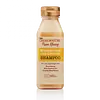What's inside
What's inside
 Benefits
Benefits

 Concerns
Concerns

 Ingredients Side-by-side
Ingredients Side-by-side

Water
Skin ConditioningSodium C14-16 Olefin Sulfonate
CleansingCocamidopropyl Betaine
CleansingCocamide Mea
EmulsifyingParfum
MaskingPolyquaternium-10
Glycol Distearate
EmollientGlycol Stearate
EmollientPolysorbate 20
EmulsifyingPanthenol
Skin ConditioningGlycerin
HumectantDimethicone
EmollientHoney
HumectantCocos Nucifera Oil
MaskingButyrospermum Parkii Butter
Skin ConditioningTriethanolamine
BufferingLauryl Alcohol Diphosphonic Acid
Emulsion StabilisingPentylene Glycol
Skin ConditioningLauric Acid
CleansingMica
Cosmetic ColorantBenzophenone-4
UV AbsorberTetrasodium EDTA
Citric Acid
BufferingPhenoxyethanol
PreservativeSodium Benzoate
MaskingMethylparaben
PreservativeEthylparaben
PreservativeCI 15985
Cosmetic ColorantCI 77891
Cosmetic ColorantCI 14700
Cosmetic ColorantCI 42090
Cosmetic ColorantWater, Sodium C14-16 Olefin Sulfonate, Cocamidopropyl Betaine, Cocamide Mea, Parfum, Polyquaternium-10, Glycol Distearate, Glycol Stearate, Polysorbate 20, Panthenol, Glycerin, Dimethicone, Honey, Cocos Nucifera Oil, Butyrospermum Parkii Butter, Triethanolamine, Lauryl Alcohol Diphosphonic Acid, Pentylene Glycol, Lauric Acid, Mica, Benzophenone-4, Tetrasodium EDTA, Citric Acid, Phenoxyethanol, Sodium Benzoate, Methylparaben, Ethylparaben, CI 15985, CI 77891, CI 14700, CI 42090
Water
Skin ConditioningSodium C14-16 Olefin Sulfonate
CleansingCocamidopropyl Hydroxysultaine
CleansingPolyquaternium-7
Cocamide Mea
EmulsifyingPropanediol
SolventHydroxypropyltrimonium Honey
Acrylamidopropyltrimonium Chloride/Acrylamide Copolymer
Phenoxyethanol
PreservativeBenzoic Acid
MaskingEthylhexylglycerin
Skin ConditioningGlycereth-2 Cocoate
EmulsifyingGlycol Distearate
EmollientYogurt Powder
Citrus Aurantium Dulcis Peel Oil
MaskingParfum
MaskingWater, Sodium C14-16 Olefin Sulfonate, Cocamidopropyl Hydroxysultaine, Polyquaternium-7, Cocamide Mea, Propanediol, Hydroxypropyltrimonium Honey, Acrylamidopropyltrimonium Chloride/Acrylamide Copolymer, Phenoxyethanol, Benzoic Acid, Ethylhexylglycerin, Glycereth-2 Cocoate, Glycol Distearate, Yogurt Powder, Citrus Aurantium Dulcis Peel Oil, Parfum
Ingredients Explained
These ingredients are found in both products.
Ingredients higher up in an ingredient list are typically present in a larger amount.
We don't have a description for Cocamide Mea yet.
Glycol Distearate serves as a pearlizing or opacifying agent in cosmetic products.
It's often included in cleansers and haircare products to give them a lustrous or shimmering appearance.
It is derived from stearic acid, a natural fatty acid commonly found in vegetable oils and animal fats.
Glycol Distearate isn't fungal acne safe.
Learn more about Glycol DistearateParfum is a catch-all term for an ingredient or more that is used to give a scent to products.
Also called "fragrance", this ingredient can be a blend of hundreds of chemicals or plant oils. This means every product with "fragrance" or "parfum" in the ingredients list is a different mixture.
For instance, Habanolide is a proprietary trade name for a specific aroma chemical. When used as a fragrance ingredient in cosmetics, most aroma chemicals fall under the broad labeling category of “FRAGRANCE” or “PARFUM” according to EU and US regulations.
The term 'parfum' or 'fragrance' is not regulated in many countries. In many cases, it is up to the brand to define this term.
For instance, many brands choose to label themselves as "fragrance-free" because they are not using synthetic fragrances. However, their products may still contain ingredients such as essential oils that are considered a fragrance by INCI standards.
One example is Calendula flower extract. Calendula is an essential oil that still imparts a scent or 'fragrance'.
Depending on the blend, the ingredients in the mixture can cause allergies and sensitivities on the skin. Some ingredients that are known EU allergens include linalool and citronellol.
Parfum can also be used to mask or cover an unpleasant scent.
The bottom line is: not all fragrances/parfum/ingredients are created equally. If you are worried about fragrances, we recommend taking a closer look at an ingredient. And of course, we always recommend speaking with a professional.
Learn more about ParfumPhenoxyethanol is a preservative that has germicide, antimicrobial, and aromatic properties. Studies show that phenoxyethanol can prevent microbial growth. By itself, it has a scent that is similar to that of a rose.
It's often used in formulations along with Caprylyl Glycol to preserve the shelf life of products.
Sodium C14-16 Olefin Sulfonate is a cleansing agent made from a mixture of long chain sulfonate salts. It can also help produce foam.
This ingredient may be drying. We recommend speaking with a professional if you have concerns.
Water. It's the most common cosmetic ingredient of all. You'll usually see it at the top of ingredient lists, meaning that it makes up the largest part of the product.
So why is it so popular? Water most often acts as a solvent - this means that it helps dissolve other ingredients into the formulation.
You'll also recognize water as that liquid we all need to stay alive. If you see this, drink a glass of water. Stay hydrated!
Learn more about Water